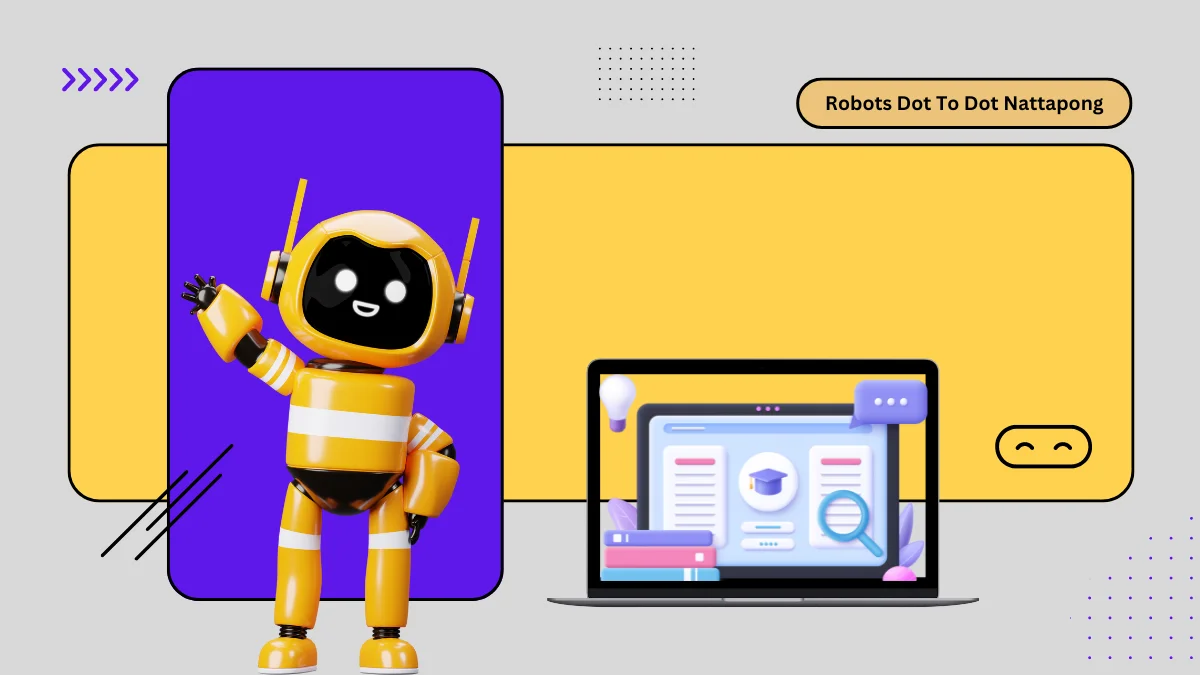In the modern era, where technology seamlessly integrates into every aspect of our lives, educational tools have evolved to include interactive and engaging methods to foster learning. One such innovative approach is the “Robots Dot To Dot” concept, which combines creativity with robotics to offer a unique learning experience. This article explores the educational benefits of “Robots Dot To Dot Nattapong,” highlighting how it aids in the cognitive and creative development of children and its relevance in Thailand’s educational context.
What is Robots Dot To Dot Nattapong?
“Robots Dot To Dot Nattapong” is an educational activity that involves connecting numbered dots to create images, often of robots, which can be further animated or brought to life using simple robotics or coding tools. This activity, designed by Nattapong, a creative educator and technologist, is tailored to engage young minds in both artistic and technological pursuits. By connecting the dots, children not only learn to recognize patterns and improve their hand-eye coordination but also gain an introduction to basic principles of robotics and coding.
Key Principles of Robots Dot To Dot Nattapong
“Robots Dot To Dot Nattapong” is based on several key principles that guide its design and implementation as an educational tool. These principles ensure that the activity is not only engaging but also effective in fostering important developmental skills in children. Here are the key principles:
1. Integration of Art and Technology
- Principle: The activity combines traditional artistic practices, like drawing and coloring, with modern technology, such as robotics and coding. This integration encourages children to see technology as a creative tool rather than just a technical subject, making learning more holistic and enjoyable.
- Impact: By merging art and technology, children develop both their creative and technical skills simultaneously, leading to a more rounded educational experience.
2. Development of Sequential Thinking
- Principle: “Robots Dot To Dot Nattapong” emphasizes the importance of following sequences, as children connect dots in numerical order to form a complete image. This reinforces the concept of order and progression, which is fundamental in both artistic endeavors and coding practices.
- Impact: Sequential thinking helps children understand the logical flow of processes, an essential skill in programming and problem-solving.
3. Encouragement of Exploration and Discovery
- Principle: The activity is designed to spark curiosity and encourage exploration. As children connect the dots, they discover the emerging image of a robot, which can then be brought to life through additional creative and technical activities.
- Impact: This principle fosters a love of discovery and learning, motivating children to explore new concepts and ideas beyond the initial activity.
4. Promotion of Fine Motor Skills and Coordination
- Principle: The physical act of connecting dots requires precision and control, helping children develop fine motor skills and hand-eye coordination. These skills are crucial for a range of activities, from writing to using technology.
- Impact: Enhancing fine motor skills at a young age supports the development of more complex physical and cognitive abilities later in life.
5. Focus on Problem-Solving and Critical Thinking
- Principle: By engaging in the dot-to-dot activity and possibly integrating simple robotics, children are encouraged to think critically about how to achieve a desired outcome. This problem-solving approach is a key element of STEM education.
- Impact: Developing problem-solving skills helps children approach challenges logically and creatively, preparing them for more complex tasks in the future.
6. Fostering Creativity and Imagination
- Principle: After the dots are connected, children are encouraged to personalize their robot with colors, decorations, and even simple animations. This open-ended aspect of the activity allows for creative expression and imagination.
- Impact: Encouraging creativity not only enhances artistic skills but also promotes innovative thinking, which is valuable in all areas of learning and development.
7. Cultural and Contextual Relevance
- Principle: The activity, developed by Nattapong, is culturally relevant, particularly in the Thai context. It is designed to resonate with local values and educational goals, making it more accessible and meaningful to children in Thailand.
- Impact: Culturally relevant educational tools are more effective in engaging students, as they feel a deeper connection to the content, leading to better learning outcomes.
8. Accessibility and Inclusivity
- Principle: “Robots Dot To Dot Nattapong” is designed to be accessible to a wide range of children, regardless of their background or skill level. The activity is simple enough for young learners to grasp, yet it can be expanded with more complex elements for advanced learners.
- Impact: Ensuring accessibility and inclusivity allows all children to benefit from the educational value of the activity, promoting equal opportunities for learning and growth.
Also Read: Boom & Bucket Google Reviews: A Comprehensive Guide of Customer Experiences
Robots Dot to Dot Nattapong categories.
- Simple Dot to Dot Robots:
- This category is designed for beginners. It involves connecting dots to create basic robot designs. The simplicity of these projects makes them ideal for those just starting out.
- Advanced Robots Dot to Dot:
- For those seeking a challenge, the advanced category allows you to create intricate designs. These projects require more concentration and precision as you connect the dots to form complex shapes.
- Themed Robots Dot to Dot:
- Themed dot-to-dot activities add an extra layer of interest. Imagine creating robot-themed art by connecting the dots! It’s a delightful blend of creativity and technology.
How Robots Dot to Dot Works?
- Dot Placement:
- Imagine a grid of dots, each representing a point on a canvas.
- The dots are strategically placed to form the outline of a robot or any other shape.
- Connecting the Dots:
- The fun begins! You connect the dots in numerical order (usually starting from 1).
- As you connect the dots, a clear image emerges, revealing the robot design.
- Algorithmic Approach:
- In the case of Robots Dot to Dot Nattapong, the process is automated using algorithms.
- A robot arm or similar mechanism follows a set of instructions to connect the dots.
- These instructions guide the robot’s movements, ensuring it connects the dots in the correct sequence.
- Precision and Creativity:
- The precision of dot placement and the robot’s movements determine the final artwork.
- The creativity lies in designing the dot patterns and choosing the right sequence for an appealing result.
- Educational Value:
- Robots Dot to Dot combines art, programming, and technology.
- It’s an engaging way to teach concepts like coordinates, sequencing, and algorithms.
Educational Benefits of Robots Dot To Dot Nattapong
- Enhances Fine Motor Skills: The act of connecting dots requires precise hand movements, which helps children develop fine motor skills. This is crucial for tasks that involve writing, drawing, and other activities that demand control over small muscle movements.
- Promotes Cognitive Development: As children work through the dot-to-dot puzzles, they learn to recognize numbers, patterns, and sequences. This cognitive exercise is essential for developing problem-solving skills and logical thinking.
- Fosters Creativity: Once the dots are connected and the robot image is complete, children can use their imagination to color and decorate the robot. This encourages creativity and self-expression, allowing each child to create a unique piece of art.
- Introduces Basic Robotics Concepts: By integrating simple robotics, such as attaching movable parts or using coding to animate the robot, children gain an early understanding of robotics. This hands-on experience lays the groundwork for more advanced STEM (Science, Technology, Engineering, and Mathematics) education.
- Encourages Focus and Patience: Completing a dot-to-dot puzzle requires concentration and patience. Children learn to focus on the task at hand, carefully following the sequence of numbers to achieve the desired outcome. This skill is beneficial in academic settings where attention to detail is crucial.
- Improves Number Recognition and Counting Skills: For younger children, dot-to-dot activities are an excellent way to reinforce number recognition and counting. As they connect the dots in numerical order, they practice these fundamental math skills in an enjoyable and interactive way.
- Builds Confidence and Achievement: Completing a dot-to-dot puzzle and seeing the final image gives children a sense of accomplishment. This boosts their confidence and encourages them to tackle more complex challenges in the future.
Also Read: 34.217.198.225 IP Address: Admin Login, Troubleshoot Fixing Tips and Range Details
The Role of Robots Dot To Dot Nattapong in Thailand’s Educational Growth
In Thailand, education is increasingly embracing technology to prepare students for a future driven by digital innovation. The “Robots Dot To Dot Nattapong” activity aligns with the country’s emphasis on STEM education, providing an engaging platform for young learners to explore the basics of robotics and coding. This approach resonates with Thailand’s educational goals, particularly in promoting creativity and problem-solving skills among students. By integrating such activities into the curriculum, Thai educators can inspire a new generation of tech-savvy individuals who are equipped to thrive in a digital world. Additionally, the cultural relevance of Nattapong’s work, being locally developed, makes it more relatable and accessible to Thai students, fostering a deeper connection to the learning material.
Conclusion
“Robots Dot To Dot Nattapong” is more than just a simple activity; it is a multifaceted educational tool that enhances various aspects of a child’s development. From improving fine motor skills to introducing the basics of robotics, this activity offers a balanced mix of creativity and learning. In Thailand, where the integration of technology into education is a growing priority, such innovative approaches are essential for preparing students to meet the challenges of the future. By embracing “Robots Dot To Dot Nattapong,” educators can provide students with the skills and knowledge they need to succeed in an increasingly digital world.




